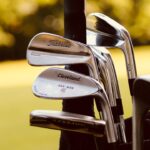- How Many Clubs Can You Have In Your Golf Bag? - April 29, 2023
- Are Golf Carts Street Legal – It Depends - April 29, 2023
- What Golf Ball Should I Use? – Complete Guide - April 29, 2023
Choosing the right golf ball can be tricky. After all, there are so many different types and brands out there! But with a little research and some savvy shopping, you’re sure to find the perfect golf ball for your game.
In this article, we’ll explore what you need to consider when selecting a golf ball, as well as which ones are best for different types of players.
Read on to discover which ball is right for you!
Our Recommendations
Professional players tend to use a high compression ball like a Titleist Pro V1, while recreational players often choose low compression balls such as the Bridgestone Tour B RX or Z Star. TaylorMade TP5x golf balls are also a fantastic option, as these offer a lot of spin on approach shots.
Choosing A Ball That Fits Your Game
When it comes to choosing the right golf ball for your game, there are a few things to consider. Your skill level and swing speed are important factors in determining the type of ball you should use.
If you have a slow swing speed, you may benefit from a ball that will help you get maximum distance, while higher handicappers or beginners may want to go with a ball that launches high and spins less. For those looking for more control and spin on their shots, a premium ball could be the right choice.
No matter what kind of golfer you are, selecting the right golf ball can help make your time on the course more enjoyable. Knowing your strengths and weaknesses is key when it comes to finding a ball that fits your game. Make sure to try different types of balls before settling on one so that you can see which model works best for you.
If you’re still unsure about which golf ball is best for your game, talk to an expert at your local golf store or pro shop. They can assess your skill level and provide advice on which type of ball would work best for you.
Additionally, some courses also offer personalized golf lessons where they can analyze your swing and recommend specific types of balls that could help improve your performance.
The bottom line is that choosing the right golf ball will depend on how well it works with your individual skillset and playing style. Do some research and experiment with different types of balls until you find one that takes your game to the next level.
Golf Ball Construction
Golf ball construction can have a major impact on the performance of a golf ball. There are two main types of golf ball construction: two-piece and multi-layer.
Two-piece golf balls have a large rubber core and a thin cover of plastic resin called Surlyn, while multi-layer golf balls have an additional layer between the core and the cover, made from various materials.
The type of golf ball you use can depend on your swing speed and spin rate, as well as desired ball flight and compression. If you have a slower swing speed, you may want to consider using a softer two-piece golf ball like the Pro V1.
This will give you more distance off the tee due to its lower compression rating. If you need even more distance, then a three- or four-piece ball might be best for you as they usually offer more carry and less spin with each shot. For those with faster swing speeds, there are also plenty of options from which to choose.
A harder two-piece golf ball like the Pro V1X will help keep your shots on line, as it has low spin rates that can help reduce sidespin when hitting into the wind. For players looking for maximum control and accuracy, a multi-layer golf ball such as the TaylorMade TP5x might be ideal due to its higher spin rates, which will provide better feel around greens and better control in windy conditions.
No matter what your needs are, there is sure to be a golf ball out there that fits them perfectly. By considering factors such as swing speed, spin rate, desired trajectory, and compression rating, you should be able to find the best option for your game that will help you shoot lower scores on the course.
Spin Rates
When it comes to spin rate, the construction of a golf ball matters. Vice golf balls are made for more spin and control on shots into the green, while Titleist Velocity and Chrome Soft balls are designed for increased speed off the tee. The Triple Track technology of the Vice Golf ball provides extra greenside spin, while the Speed Dimple technology found in Titleist Velocity and Chrome Soft balls helps reduce drag from air resistance.
The PGA Tour is filled with strong players who rely heavily on spin rate to maximize their shots. As such, they often use different varieties of golf balls to tailor their performance to their style of play. For instance, some players prefer a urethane ball with an increased spin rate off their wedges or irons, while others may opt for a golf ball with low spin rates off their driver.
To choose the best golf ball for your game, you should consider your current swing speed and trajectory when trying out different types of golf balls. If you’re looking for maximum distance off the tee, then a Titleist Velocity or Chrome Soft would be your best option.
On the other hand, if you’re looking for more control around the green, then a Vice Golf might be better suited for you. It’s essential to experiment with different brands and types of golf balls to find which works best for your game.
Test out how each one performs off various clubs so that you can get an understanding of how much spin rate each golf ball has and which one suits your style of play better. This way, you can make sure that you’re using the right kind of golf ball every time you hit the course.
Compression
When it comes to the compression of a golf ball, it’s important to consider many aspects. Compression ratings range from 30 to 120, with lower numbers indicating softer balls. Golfers with slower swing speeds, under 85 MPH, should opt for a low compression ball. For swings between 85 and 95 MPH, a mid-compression ball is recommended5. High compression golf balls are designed for players who swing faster than 95 mph.
The construction of a golf ball has an effect on the compression as well. Different materials used in the core and cover can create different levels of compressibility. A golf ball’s construction also affects how much spin is created when the ball compresses against the clubface3. The number of dimples on a golf ball can also affect its performance.
| Low Compression | Mid Compression | High Compression |
| :————-: | :————-: | :————–: |
| <85 mph | 85-95 mph | >95 mph |
| Soft | Medium | Hard |
Golfers should select their balls based on their individual needs and preferences. If you’re looking for more distance off your driver, low compression balls are often recommended. Players looking for more accuracy may prefer higher compression balls. Ultimately, finding the right golf ball is all about experimentation and understanding your own game.
No matter what level of golfer you are or what type of shots you need to hit, it’s important to choose a golf ball that fits your playing style and swing speed. With so many options available today, there’s sure to be one that meets your unique needs!
Dimple Patterns
Compression is an important factor when choosing the right golf ball for you. Lake balls and recycled golf balls are also available for those on a budget.
Premium golf balls have both a soft cover and a core that can provide more spin off the tee, as well as around the greens. These higher end models are usually made with five-piece construction and are designed to reduce drag and increase lift in order to maximize distance and accuracy.
The dimple pattern on the surface of a golf ball plays an integral role in its flight characteristics. Most manufacturers design their dimples in such a way that they provide maximum lift by breaking up the air around the ball during flight, thus reducing drag and increasing distance. Some even go as far as creating specific patterns for different types of shots, depending on how much spin is desired.
No matter what type of golfer you are, there are plenty of options when it comes to selecting the perfect golf ball for your game. Whether you’re looking for something to help you get more distance off the tee or something that will give you better control around the greens, there’s sure to be a ball out there that meets your needs.
Frequently Asked Questions
How Much Does A Golf Ball Typically Cost?
A golf ball typically costs between $1.50 – $5 each, depending on the brand and type.
Different materials, such as urethane, can cost more than the average range.
Price is often an indication of quality and durability, so it’s important to consider your needs before investing in a specific model.
How Do I Clean My Golf Ball?
Cleaning your golf ball is easy and important for maintaining its performance.
To do so, you can use a damp towel, mild soap or an all-purpose cleaner.
Start by wetting the towel with lukewarm water, then add a few drops of the cleaner to it.
Gently rub the golf ball with the towel in a circular motion until dirt and grime are removed.
Once you’re done cleaning, dry off the golf ball with a clean cloth before using it again.
What Type Of Golf Ball Is Best For Beginners?
If you’re a beginner golfer, it can be daunting to decide on the best type of golf ball to use.
It’s important to remember that the type of golf ball you choose has an effect on your distance and spin control.
A two-piece golf ball is generally recommended for beginners because they are more durable and provide more distance than other types while still providing some spin control.
They also tend to be less expensive than premium balls, making them a great option for newcomers.
How Often Should I Replace My Golf Ball?
Replacing your golf ball is important in order to ensure you get the most out of it.
Generally speaking, you should replace your golf ball every 3-4 holes, as the dimples on the surface become less effective over time and can impact the accuracy of your shots.
Additionally, if you notice any visible damage or scuffs on the ball, it’s best to replace it right away.
How Can I Hit The Golf Ball Further?
Hitting the golf ball further can be accomplished by making a few small adjustments to your technique.
Start with your grip – ensure you have a light grip on the club and keep your hands in sync throughout your swing.
You should also practice driving with a bit of an ascending motion, where you raise the club head through impact while maintaining good posture.
Finally, focus on having a consistent tempo and rhythm – this will help you maintain solid contact and maximize distance.
Conclusion
I hope I’ve helped you to figure out what golf ball is best for you.
As a beginner, it’s important to choose a ball that won’t break the bank, but will still give you good performance.
Don’t forget to clean your golf balls regularly, and replace them if they become scuffed or cracked.
Finally, practice with different types of swings to help maximize your distance off the tee.
All these things should help you find the perfect golf ball for your game!
Good luck!







